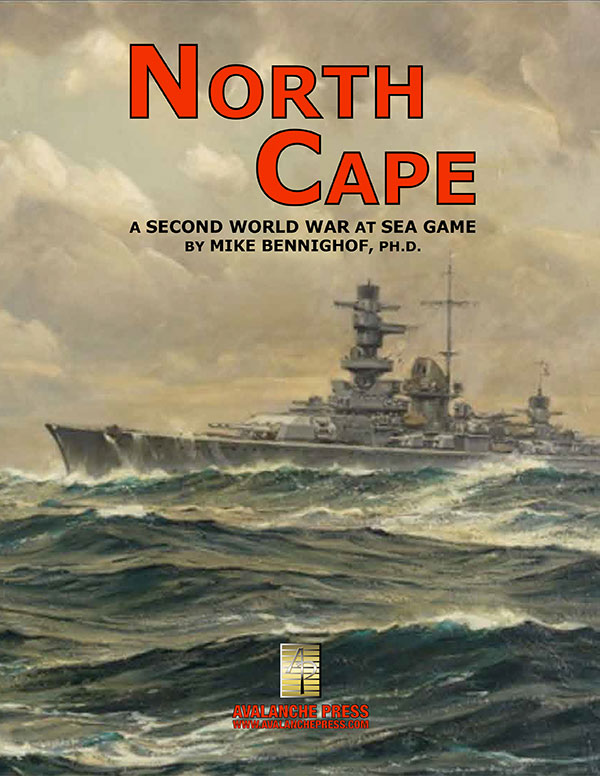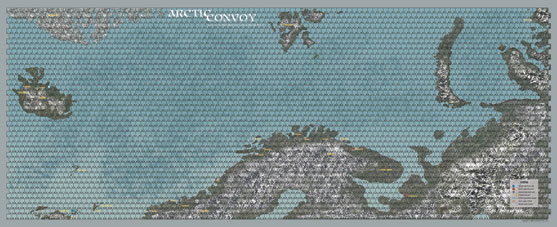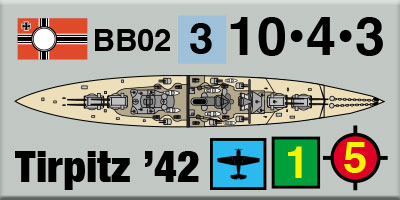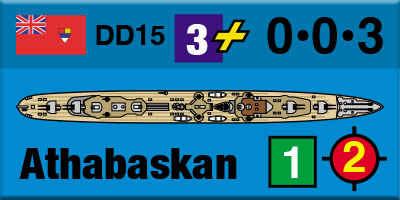| North Cape:
Chapter One: The First Year
By Mike Bennighof, Ph.D.
December 2024
 Second World War at Sea: North Cape is a re-imagining of our old Arctic Convoy game, based on convoy operations in the Arctic (I do like descriptive titles). Arctic Convoy was by no means a bad game; when we first released it in 2008, I considered it one of the best games we’d made up to that point. Second World War at Sea: North Cape is a re-imagining of our old Arctic Convoy game, based on convoy operations in the Arctic (I do like descriptive titles). Arctic Convoy was by no means a bad game; when we first released it in 2008, I considered it one of the best games we’d made up to that point.
But that point was a long time ago, and my standards have changed. I’ve come to see wargames as a mechanism for story-telling, to show how a historical event unfolded in a way that narrative history really can’t. So I decided to re-make Arctic Convoy along the same lines as our recent Second World War at Sea games, and the changes became so thorough that it deserved a new title, North Cape.
Arctic Convoy did not follow our now-standard story-arc format, with the scenarios broken into chapters, in which the story unfolds through the scenarios. It also pre-dates my epiphany regarding the battle scenarios in our naval games.
There are two kinds of scenarios in a Second World War at Sea game. Operational scenarios take place on the operational map (the one that shows the oceans and seas and ports and stuff). The task forces move there, and when they make contact, they fight on the Tactical Map. Battle scenarios skip that step, and go straight to the fighting on the Tactical Map.
Battle scenarios are great story-telling devices, from my designer/author perspective. They let you (the designer) put emphasis on the actions that arose from the operation, and perhaps more importantly, could have arisen. The ones based on battles that didn’t happen often show why one side wanted to avoid combat.
And they add great play value, from the player’s perspective, since they give you a way to play every operation described in the game, moving right to the Tactical Map and fighting there with guns and torpedoes. They resolve fairly quickly, so you can play several of them in a single game session (depending on the battle).

North Cape’s first chapter covers the first British convoys, small and poorly-organized, and the first tentative German operations along the Arctic coast, likewise small and poorly-organized. It rolls in just two scenarios from the old Arctic Convoy, one operational and one battle, and adds six more: two new operational scenarios, and five new battle scenarios.
That turns it from a couple of unrelated topics (the first British convoy, and a clash between German destroyers and a mixed British/Soviet surface action group), into a more coherent story.
We lead off with the first German probes eastward with a destroyer flotilla, following the launch of Operation Barbarossa. There’s an operational scenario, and a battle scenario, as the Germans probed east just as the Soviets sent a small force west to land troops behind German lines. They failed to meet each other in the actual event, but we have a scenario assuming slightly more German competence.

That gives us a small, not overly long operational scenario taking place on just a small part of the operational map. Exactly how new players should be introduced to the game system.
The original first scenario operational scenario, based on the first British convoy operation, required the full map and went on for great length (because the Brits have to cross nearly the entire map, which is very large). It’s also loaded with special rules, because Winston Churchill could not help himself and wanted all sorts of feats of derring-do attached to the core mission: a side trip to Spitzbergen, added transport missions bringing mines to Murmansk and fighter planes, too. Raids by cruisers on German coastal shipping and by carrier planes on German airfields. It was an overly-complex mission, and Home Fleet commander Jack Tovey made sure it would be the last such.
Daily Content includes no AI-generated content or third-party ads. We work hard to keep it that way, and that’s a lot of work. You can help us keep things that way with your gift through this link right here.
All of those extras left the actual convoy with a fairly weak escort, one that would have had trouble fending off the lone German destroyer flotilla then operating in the north. So of course we’ve added a companion battle scenario for the latter. And while we have a complex operational scenario, it’s no longer the very first one.

During 1941, six convoys made the trek from Iceland to northern Russia. Some went to Murmansk, some went to Arkhangel’sk, and some of them actually went to both. The journey to Arkhangel’sk was much longer (an extra 250 nautical miles), and the port froze over for about half of the year. But it had much more developed facilities than Murmansk, and was much farther from German airfields.
Of those, we only covered one in a scenario. It’s tempting to include all six (and the return convoys for each; these usually sailed at the same time as an incoming convoy so there would not be separate scenarios). I felt that would get kind of repetitive, especially as at this point in the war the Germans had not really started to contest the traffic with their full weight of air, surface, and submarine forces.
So instead of giving all six the full treatment, I focused on just one, PQ6 in mid- to late-December 1941, and only on the tail end. Players don’t have to trace the full route from Iceland; instead, the action picks up just as the convoy has split, with some ships heading on into the White Sea on their way to Arkhangel’sk while the others, and the escort, doubled back to Murmansk. That’s a lot of maneuvering within reach of the Germans, who aren’t as good at this whole war-at-sea stuff as their fanboys would have it, but they only need to be lucky once.

That gives us the operational background for our existing battle scenario, a small battle that actually took place between the German destroyers and a British cruiser supported by two Soviet destroyers. And we add another, pitting those same Germans against the Murmansk-bound portion of Convoy PQ6 and its escort (this one did not happen, but would have been the German goal with better Air Force/Navy cooperation).
Chapter One sets the stage for the rest of the game. Neither side is as yet taking this theater very seriously: the British are not giving the convoys sufficient protection, but that’s okay for now, as the Germans aren’t trying very hard to stop them. It’s a clash of minimal forces, for the most part.
The campaign is dictated by geography and to an even greater extend by hydrography. The North Atlantic Current, a branch of the Gulf Stream, warms the waters of Murmansk on Kola Bay enough o keep the port ice-free year-round, even though in the 1940’s the temperature remained below freezing between October and May (this has not been true in recent years, as the climate has warmed). Arkhangel’sk froze over in December and remained ice-locked until June.

The Tsarist regime built the port at Murmansk to receive military aid during the First World War, but in 1941 Murmansk still lacked extensive port facilities (like cranes capable of unloading tanks). But the convoys would head to Murmansk anyway, well within range of the German airfields and small naval base at Kirkenes, just 155 kilometers away as the penguin flies.
In the new year, though, the Germans would commit much more force to the disruption effort, including heavy surface ships plus a great many more submarines and aircraft. The British would have to match and exceed that deployment. Next time, we’ll look at how that translates into game play
You can order North Cape right here.
Sign up for our newsletter right here. Your info will never be sold or transferred; we'll just use it to update you on new games and new offers.
Mike Bennighof is president of Avalanche Press and holds a doctorate in history from Emory University. A Fulbright Scholar and NASA Journalist in Space finalist, he has published a great many books, games and articles on historical subjects; people are saying that some of them are actually good.
He lives in Birmingham, Alabama with his wife and three children. He misses his lizard-hunting Iron Dog, Leopold.
Daily Content includes no AI-generated content or third-party ads. We work hard to keep it that way, and that’s a lot of work. You can help us keep things that way with your gift through this link right here.
|
